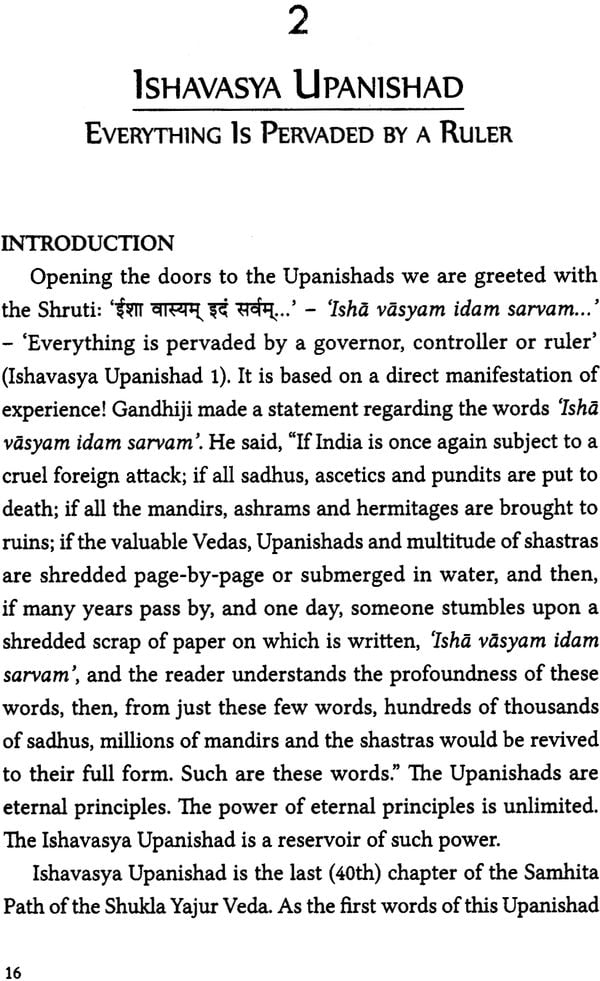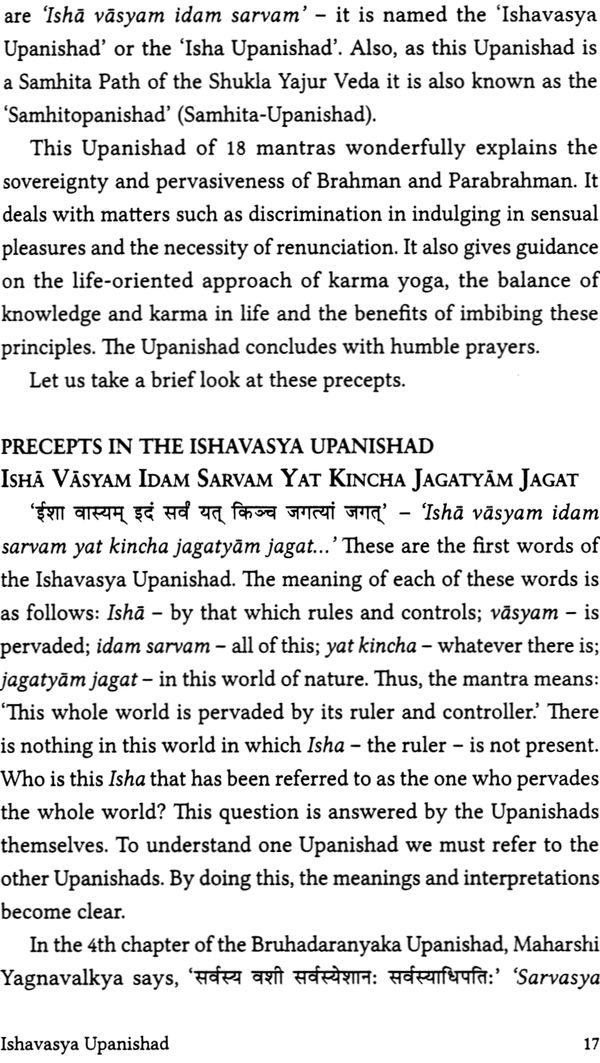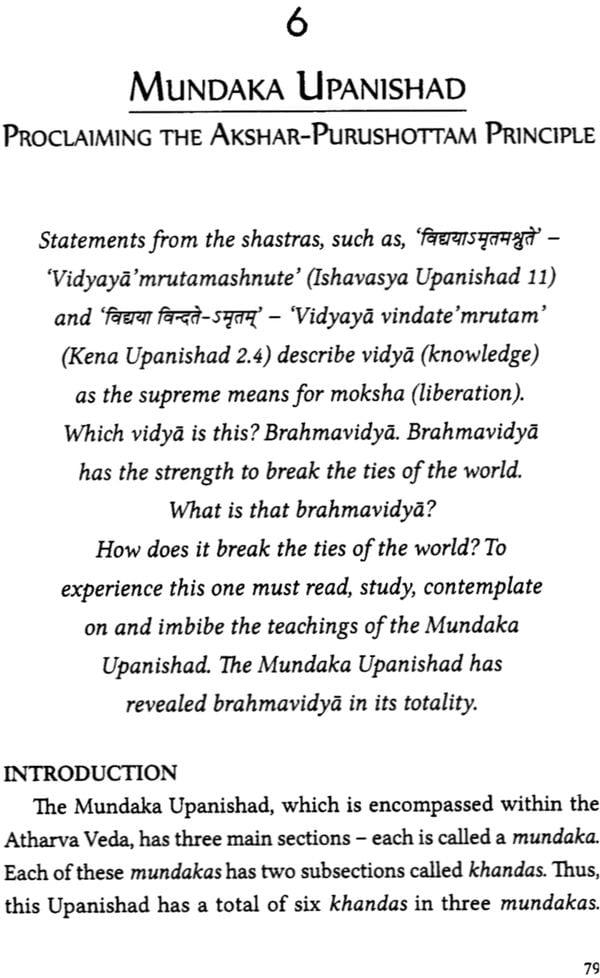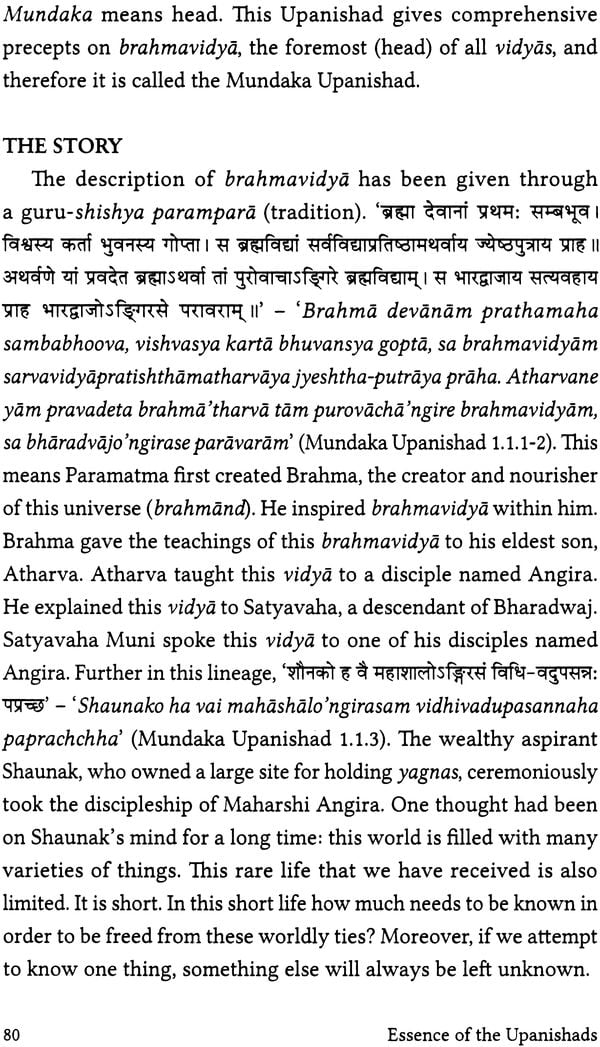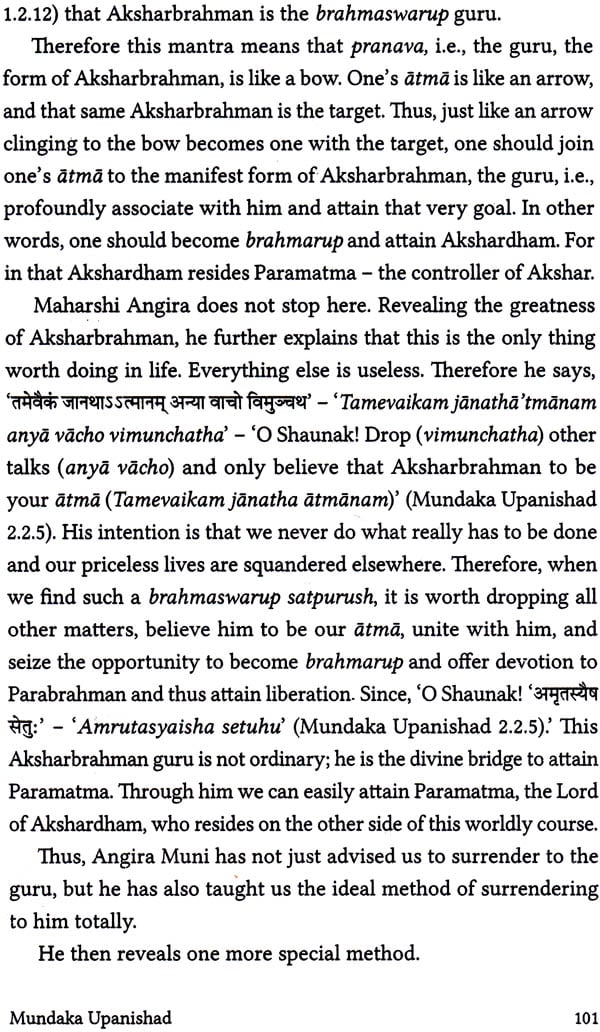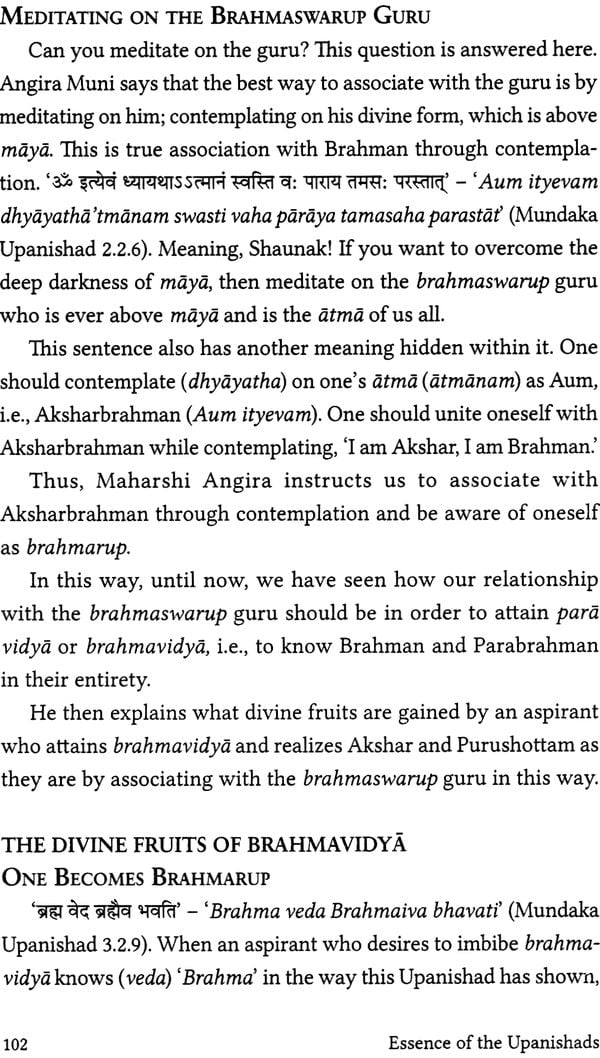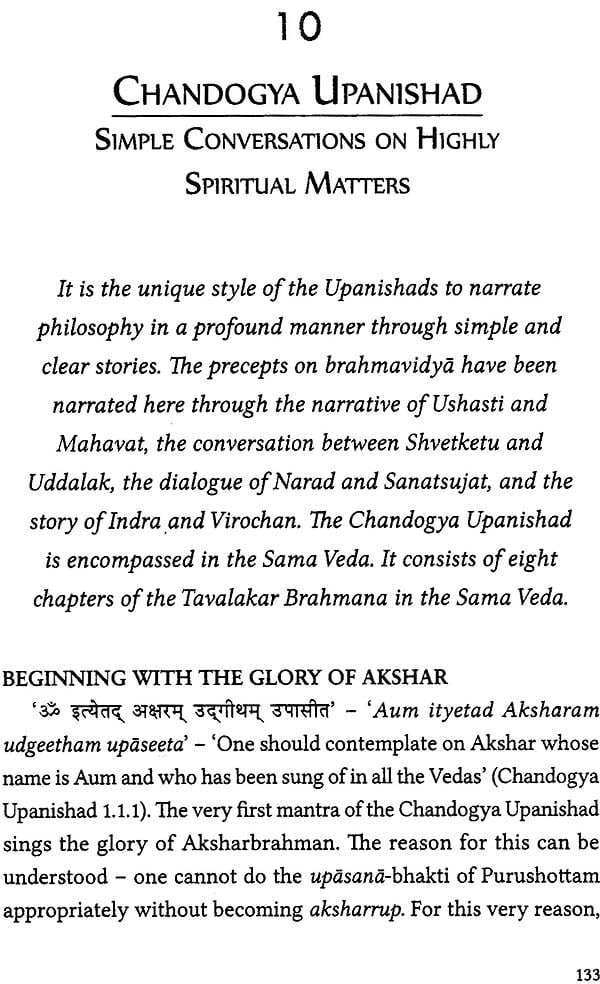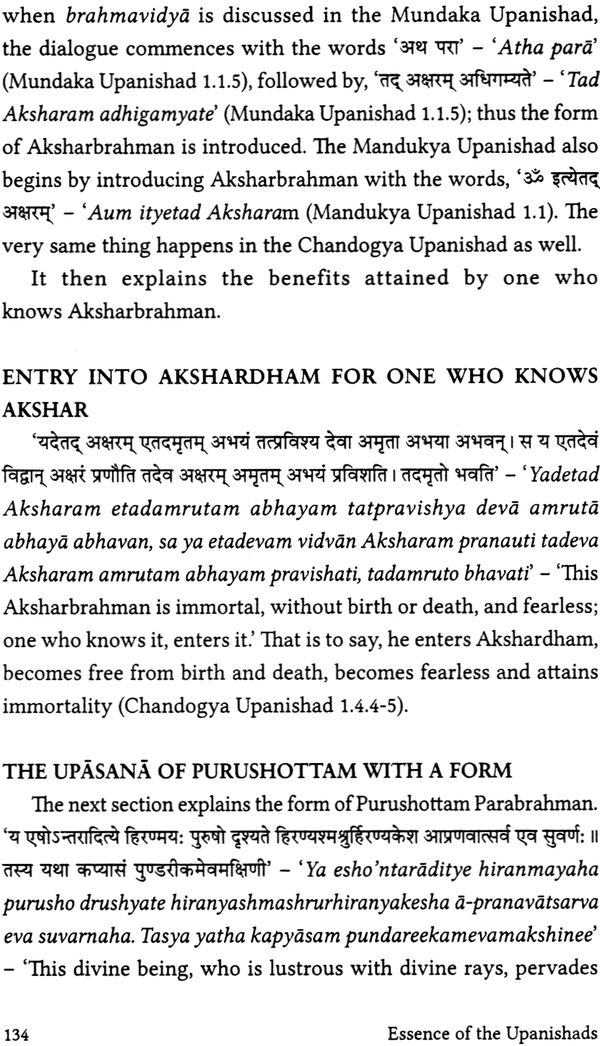
Essence of The Upanishads (The Wisdom of Ancient Rishis)
Book Specification
| Item Code: | NAJ779 |
| Author: | Sadhu Paramvivekdas |
| Publisher: | Swaminarayan Aksharpith |
| Language: | English |
| Edition: | 2012 |
| ISBN: | 9788175263529 |
| Pages: | 214 |
| Cover: | Paperback |
| Other Details | 9.0 inch X 6.0 inch |
| Weight | 210 gm |
Book Description
Many spiritual texts represent the summit of world literature. Among them, the shastras of Sanatana Hindu Dharma teach the highest moral, philosophical and spiritual truths in a concise and clear way. Of the many Hindu shastras, the Upanishads provide the philosophical basis for all Hindu sampradayas.
The Upanishads are an integral part of the Vedas, and since they are located at the end of the vast Vedic body of literature, the Upanishads are also often referred to as ‘Vedanta’.
The Upanishads also provide a framework for the unique and divine philosophical and spiritual principles taught by Bhagwan Shri Swaminaraya.
The practical and spiritually elevating philosophy of Akshar-Purushottam revealed by Bhagwan Swaminarayan (1781-1830 CE) in the early nineteenth century is a 'unique contribution to the annals of Sanatana Hindu Dharma, It is rooted in the Vedas and is also contained in the Prasthantrayi, the Upanishads, Bhagavad Gita and Brahmasutras.
WHAT ARE SHASTRAS?
'Shasti cha trayate cha iti shiistram.
- 'That which rules and protects is a shastra'. Hindu shastras have continuously taught eternal principles to make man's sentiments become more spiritual, more stable, more profound and more enlightened. They have all along inspired rituals that are relevant to these principles, and prohibited those that seem contradictory to them. They guide us by distinctly describing the means that enable us to follow those rituals.
Anekasanshayocchedi parokshartham darshakam,
Sarvasya lochanam shastram yasya nastyandha eva saha.
Meaning, 'Shastras uproot doubts and clarify principles that seem imperceptible. They are the true eyes of man. Therefore, one who does not read and associate with shastras is certainly blind.'
In this chapter, we will acquaint ourselves with the three foremost of the many Hindu shastras. Collectively known as the prasthantrayi, these three shastras have been stamped with authority as philosophical treatises.
PRASTHANTRAYI
Prasthan means a shastra that establishes principles, and the suffix trayi indicates a quantity of three. The three shastras which comprise the prasthantrayi are the Upanishads, Shrimad Bhagavad Gita and Brahmasutras. These shastras are named prasthan because it is only through them that philosophical principles are established (prasthapan).
Hindu saniitana sampradayas have always established, supported and promoted their philosophical principles using the prasthan shastras. This unique tradition started in ancient times. Acharyas such as Shankaracharya, Ramanujacharya, Madhvacharya, Nimbarkacharya, Vallabhacharya, Ramanandacharya and others, have written commentaries on these shastras. Similarly, commentaries on these three shastras have also been written in the Swaminarayan Sampradaya.
The three prasthan shastras are considered as the supreme authority in matters of philosophy amongst followers of Hindu Sanatana Dharma.
THE FIRST PRASTHAN: THE UPANISHADS
Arthur Schopenhauer (1788-1860), a renowned German philosopher, once said, "From every sentence deep, original and sublime thoughts arise, and the whole shastra is pervaded by a high and holy and earnest spirit.... In the whole world there is no study, except that of the originals, so beneficial and so elevating as that of the Upanishads. And therefore the Upanishads have been the solace of my life, they will be the solace of my death:'
Max Muller (1823-1900), a famous German scholar, echoed this sentiment when he said, "If these words of Schopenhauer need any confirmation, I willingly give mine:'
Swami Vivekanand (1863-1902) commented, "We need strength. Who will give us strength? The Upanishads are a treasury of strength. They are capable of giving strength.” Many luminaries have thus studied and experienced the Upanishads with astonishment.
The Upanishads epitomize the greatest literature our world has seen. The Upanishads liberate people mired in misery and inspire them to trek the path of eternal peace and happiness. They reveal, "Tarati shokamatmavid' - 'One who attains the knowledge of Paramatma overcomes grief' (Chandogya Upanishad - 'Adhyatmayogadhigamena devam matva dheero harshashokau jahati' - 'The resolute person, who, having attained the brahmi- sthiti (brahmic state) of adhyatma yoga, contemplates upon and offers his devotion to Parabrahman, becomes detached from worldly delight and grief' (Katha Upanishad 1.2.12). Such mantras lead man further in the direction of eternal peace and happiness.
What is that Paramatma like? 'Yo vai bhooma tatsukham nalpe sukhamasti' - Only Paramatma, who is the greatest of all, is full of bliss. The whole of creation, which is inferior to him, contains no bliss' (Chandogya Upanishad 7.23.1).
How can we attain Paramatma? The Upanishads disclose, I' - 'Brahmavidapnoti param.' - 'One who becomes aksharrup (brahmarup) attains Parabrahman' (Taittiriya Upanishad, Anandavalli, Mantra 1).
They reveal that - 'Na pashyo mrutyum pashyati na rogam nota duhkhatam' - 'Disease, misery, birth and death no longer remain for one who has attained brahmavidyii (the true knowledge of Brahman and Parabrahman)' (Chandogya Upanishad 7.26.2).' Such teachings bestow man with moksha.
They counsel - 'Atma va are drashtavyaha shrotavyo mantavyo nididhyasitavyaha' - 'One should experience Paramatma; therefore one should listen to talks about him, reflect upon him and meditate upon him' (Bruhadaranyaka Upanishad 2.4.5).
One cannot help but realize that the Upanishads are an ocean of eternal principles: indisputable 'manuals for the realization of ultimate peace and happiness. Their pure and divine streams have gifted the world with serenity.
WHAT DOES 'UPANISHAD' MEAN?
The philosophical definition of Upanishad is as follows: - 'Upanishadyate prnpyate gnayate brahmavidyii anaya iti Upanishad. J - 'That by which brahmavidya can be known and attained is Upanishad.' Taken literally, upa means 'near' and nishad means 'to sit'. Therefore, 'Upanishad' can also mean upasani; (since, asana also means 'to sit'). The Upanishads are the shastras of upasana. Therefore the message of accepting the discipleship of the brahmaswarup guru, attaining brahmavidya from that guru and offering upiisanii to Parabrahman echoes from the very word 'Upanishads:
THE LOCATION OF THE UPANISHADS
The Upanishads are based in the Vedas. They are actually a specific part of the Vedas. Moreover, they are a concise collection of the deep philosophical principles of the Vedas. That is why the Upanishads are also known as Vedanta.
WHO CREATED THE UPANISHADS?
In Sanatana Dharma the knowledge of the Vedas is revered as being without a beginning, eternal and of divine origin. The Upanishads are a part of the Vedas. Therefore, questions regarding who wrote the Upanishads and when they were written do not apply. Our sanatana shastras clearly explain that at the beginning of a kalp Paramatma himself sequentially manifests them as they were before (Shrimad Bhagavat 3.12.37-38). For this reason, the Nirukta, a supporting shastra of the Vedas and, in effect, a Vedic dictionary, states that the rishis have been inspired to reveal the Vedic mantras, but they are not the composers (Nirukta, Naigamkand 2.11). Maharshi Parashar also says, - 'Na kashchid Vedakarta.' - 'There is no creator of the Vedas:
Therefore, questions regarding the sequence of the Upanishads - which was created first and which later? - are inapplicable and run counter to sanatana Vedic principles. Moreover, great, wise rishis, like Maharshi Manu, have called the Upanishads 'Anadinidhana divya vak' - 'Eternal divine precepts' (Manu Smruti). Thus, Hindu spiritual traditions accept that the Upanishads are without a beginning, eternal and not of human origin. Bhagwan Swaminarayan also mentions in his discourses that the Upanishads are eternal shastras.
| Publisher's Note | vi | |
| 1 | Introduction | |
| Introduction to the Prasthantrayi | 1 | |
| 2 | Ishavasya Upanishad | |
| Everything Is Pervaded by a Ruler | 16 | |
| 3 | Kena Upanishad | |
| The Secret to the Source of All Energy | 31 | |
| 4 | Katha Upanishad | |
| The Secret of Life After Death | 42 | |
| 5 | Prashna Upanishad | |
| A Conversation on Spirituality | 68 | |
| 6 | Mundaka Upanishad | |
| Proclaiming the Akshar-Purushottam Principle | 79 | |
| 7 | Mundaka Upanishad | |
| Precepts on the Ultimate State of the Atma | 107 | |
| 8 | Taittiriya Upanishad | |
| The Testimony of a Complete Education | 113 | |
| 9 | Aitareya Upanishad | |
| Acquaintance with the Essence of Creation | 128 | |
| 10 | Chandogya Upanishad | |
| Simple Conversations of Highly Spiritual Matters | 133 | |
| 11 | Bruhadaranyaka Upanishad | |
| Spiritual Song of the Forest | 151 | |
| 12 | Summary | |
| Brahman: A Description from the Prasthantrayi | 166 | |
| Appendix | 188 | |
| Glossary | 192 | |
| Index | 202 |
